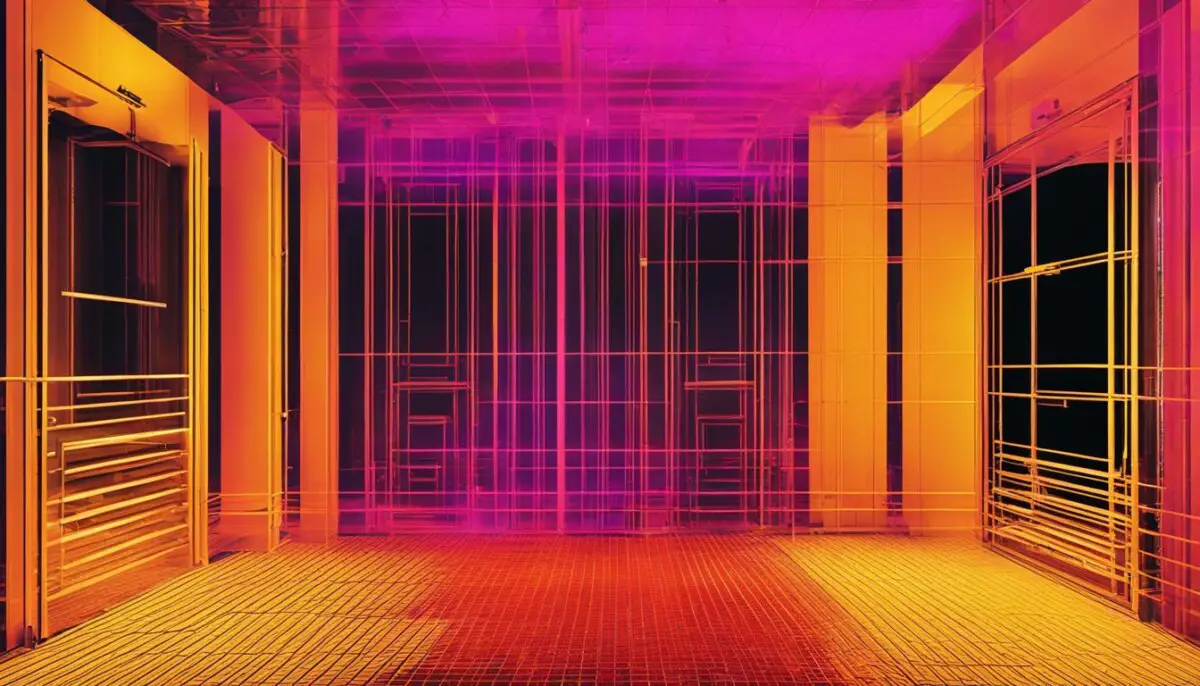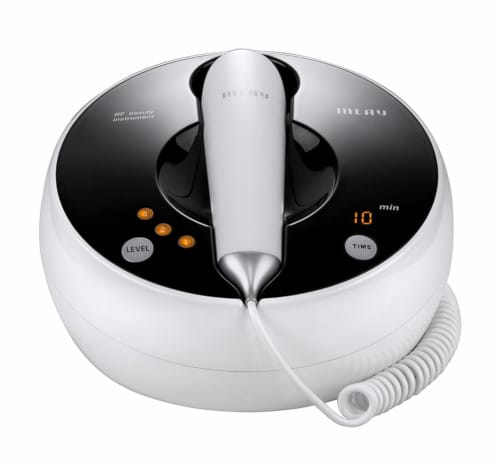Last Updated on 6 months by Francis
If you’re in the market for a new heater, you might be wondering which is better: an infrared or a convection heater? Both types have their pros and cons, and the decision ultimately depends on your individual needs and preferences.
In this article, we’ll provide an in-depth comparison of infrared and convection heaters to help you make an informed choice. We’ll cover everything from how these heaters work to their energy efficiency and heating capacity. So, let’s dive in and explore the world of infrared and convection heaters!
Contents
Key Takeaways:
- Choosing between an infrared or convection heater depends on your individual needs and preferences.
- This article will provide an in-depth comparison of the two types of heaters.
- We’ll cover everything from how the heaters work to their energy efficiency and heating capacity.
- Ultimately, the decision comes down to a combination of factors, including room size, heating needs, safety features, and personal preferences.
- By the end of this article, you’ll have a better understanding of which type of heater is better suited for your needs.
Understanding Infrared Heaters
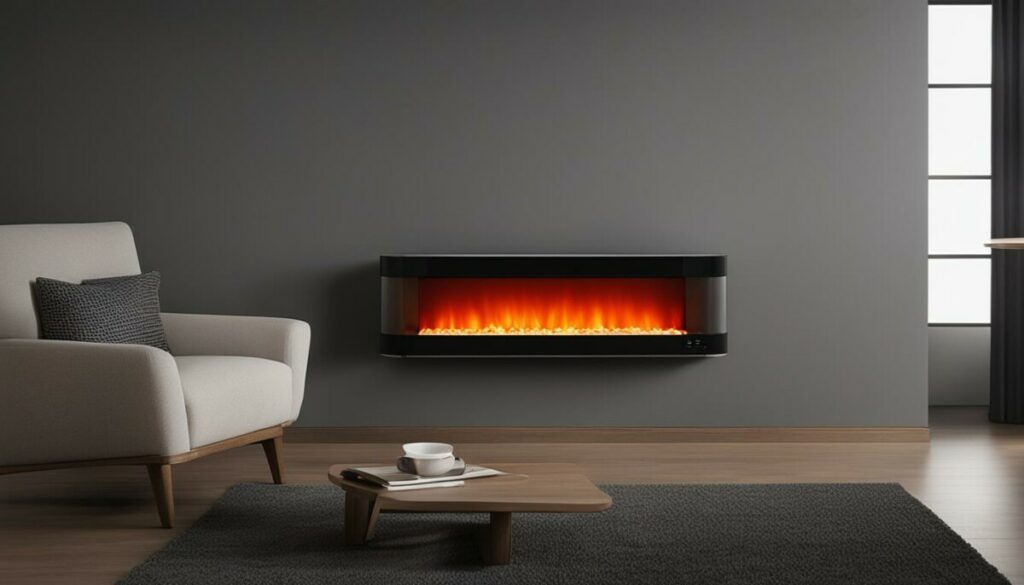
Are you searching for the best infrared heater to keep you warm during the cold winter months? Look no further! In this section, we will explore the benefits of infrared heaters and how they compare to convection heaters.
Benefits of Infrared Heaters
Infrared heaters are known for their exceptional ability to heat objects and surfaces directly. This means that instead of warming the air around you, infrared heaters produce heat that is absorbed by your body and surrounding objects, creating a cozy, comfortable atmosphere.
Compared to convection heaters, infrared heaters are more energy-efficient, as they require less power to effectively heat a room. They are also highly portable, making them easy to move from room to room as needed. Plus, because they emit heat without a fan, they operate quietly, ensuring a peaceful environment.
Comparison Between Infrared Heater and Convection Heater
While both infrared and convection heaters serve the same purpose of heating a space, they function in different ways. Convection heaters, for example, work by heating the surrounding air and circulating it throughout the room. This makes them effective in large, open spaces with good ventilation.
On the other hand, infrared heaters are better suited for smaller rooms or spaces with limited ventilation, as they generate heat that is directly absorbed by people and objects in close proximity. They are also ideal for outdoor use, as they are less affected by wind and other environmental factors.
| Feature | Infrared Heater | Convection Heater |
|---|---|---|
| Heating Mechanism | Direct heating through infrared radiation | Heating the air and circulating it throughout the room |
| Energy Efficiency | More energy-efficient, as they require less power to generate heat | Less energy-efficient, as they need more power to heat the air |
| Heating Capacity | Effective in small rooms or areas with limited ventilation | Effective in large, open spaces with good ventilation |
When it comes down to it, the choice between an infrared heater and a convection heater ultimately depends on your individual needs and preferences. Consider factors such as the size of the room you need to heat, the level of ventilation, and the portability of the heater.
Now that you have a better understanding of infrared heaters and their benefits, it’s time to start shopping for the perfect one for your home. Keep in mind the pros and cons of both infrared and convection heaters when making your decision and choose the one that best suits your needs.
Exploring Convection Heaters
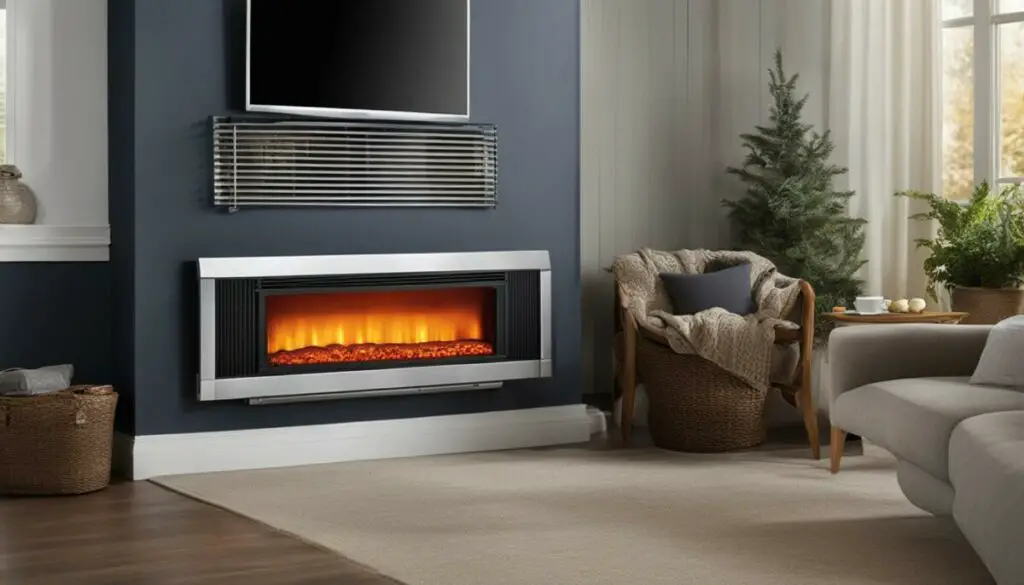
Convection heaters are a popular choice for providing warmth in homes and businesses. These heaters work by warming the air and circulating it throughout the room to heat up the surrounding surfaces and objects.
One of the benefits of convection heaters is their ability to provide consistent and even heating, making them well suited for larger spaces. They also tend to be more affordable compared to other types of heaters, making them a preferred option for those on a budget.
When comparing infrared and convection heaters, one advantage of the latter is that they don’t require direct line-of-sight to effectively heat a space. This makes them a good choice for heating up entire rooms.
Another benefit of convection heaters is that they can be used to humidify a room. As the heater heats up the air, it also increases the level of moisture in the room, helping to combat dryness and respiratory problems.
When it comes to choosing the best convection heater for your needs, there are several factors to consider. Size and heating capacity are important considerations, as well as safety features such as overheat protection and tip-over switches.
Here are some of the top-rated convection heaters currently on the market:
| Product | Features | Price |
|---|---|---|
| Lasko 755320 Ceramic Space Heater | Adjustable thermostat, oscillation, remote control | $70 |
| DeLonghi EW7707CM | Adjustable thermostat, anti-freeze setting, 24-hour programmable timer | $100 |
| Honeywell HZ-789 EnergySmart Electric Oil Filled Radiator | Energy-efficient, three heat settings, digital controls | $130 |
Overall, convection heaters are a reliable and cost-effective option for keeping your home warm and comfortable during the colder months. Consider your specific heating needs and preferences to determine if a convection heater is the best choice for you.
Heating Mechanism: How does Infrared Work?
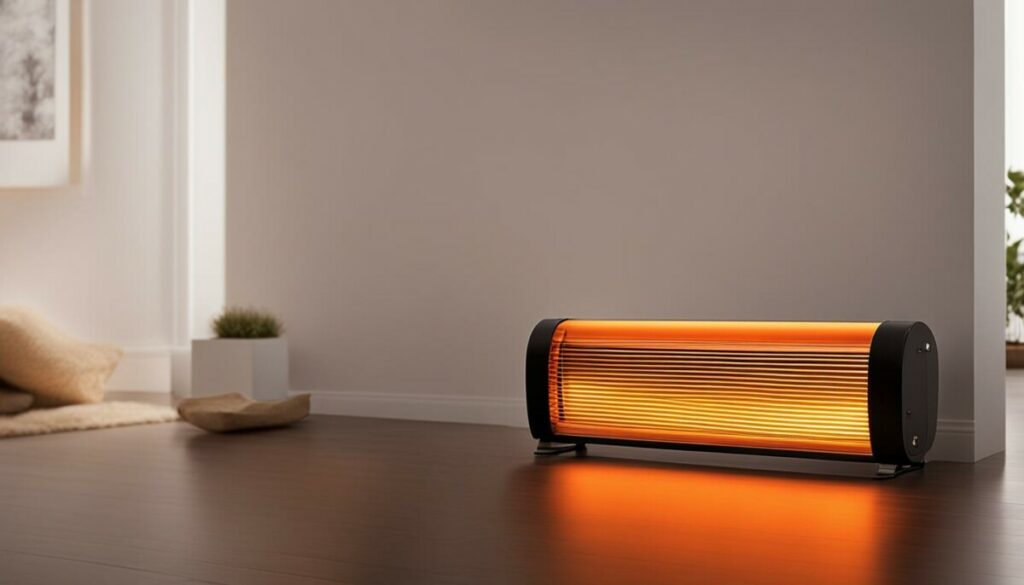
Infrared heaters work by emitting infrared radiation, which is absorbed by objects and people in the room, warming them up directly. This process is similar to the way the sun heats the earth. Infrared heaters do not heat up the air in the same way that convection heaters do, making them a popular choice for those looking for targeted, spot heating.
One of the key advantages of infrared heating is its ability to provide instant heat. Unlike convection heaters, which can take a while to warm up a room, infrared heaters start providing heat as soon as they are turned on. This makes them ideal for use in rooms that are only occupied for short periods of time, as well as outdoor spaces and garages.
Infrared heaters are also popular for their energy efficiency. Because they do not heat up the air, they are able to provide more targeted heating using less energy. This can lead to lower energy bills and a smaller carbon footprint. Additionally, because they do not rely on moving air, they are less likely to spread allergens and dust around the room.
However, there are some potential downsides to infrared heaters to consider. For example, because they do not heat up the air, they may not be the best option for larger rooms or for those looking for all-around heating. They also do not have a built-in fan to circulate the heat, which can sometimes lead to uneven heating in the room.
Overall, infrared heaters are a great option for those looking for targeted, instant heat that is energy-efficient and easy to use.
“Infrared heaters are a great option for those looking for targeted, instant heat that is energy-efficient and easy to use.”
Heating Mechanism: How does Convection Work?

Unlike infrared heaters that use radiation to emit heat, convection heaters operate by heating the air in a room and circulating it to provide warmth. The process involves drawing in cool air from the environment and heating it using an electric element or gas burner.
As the air warms up, it rises and displaces the cooler air, which sinks towards the source of the heat. This cycle continues, creating a convection current that gradually raises the temperature in the room. Convection heaters are effective in providing overall warmth, making them suitable for larger spaces.
However, convection heaters require time to warm up the air, making them slower to provide heat than infrared heaters. They also tend to distribute heat unevenly, with the highest temperatures near the heater and cooler spots farther away.
Infrared vs Convection Heater:
| Heating Mechanism | Pros | Cons |
|---|---|---|
| Infrared Heater | – Provides instant heat to objects and people – Operates quietly – Does not create air currents or dry air |
– May not be effective in large or drafty spaces – Can be more expensive to purchase |
| Convection Heater | – Provides overall warmth to a room – Suitable for larger spaces – Usually less expensive to purchase |
– Takes longer to heat up a room – Distributes heat unevenly – Can create air currents and dry air |
When choosing between an infrared and convection heater, it’s essential to consider your heating needs, the size of the space you want to heat, and your budget. Infrared heaters work best in smaller, well-insulated rooms, while convection heaters are suitable for more extensive spaces that need overall warmth.
Energy Efficiency and Cost-effectiveness
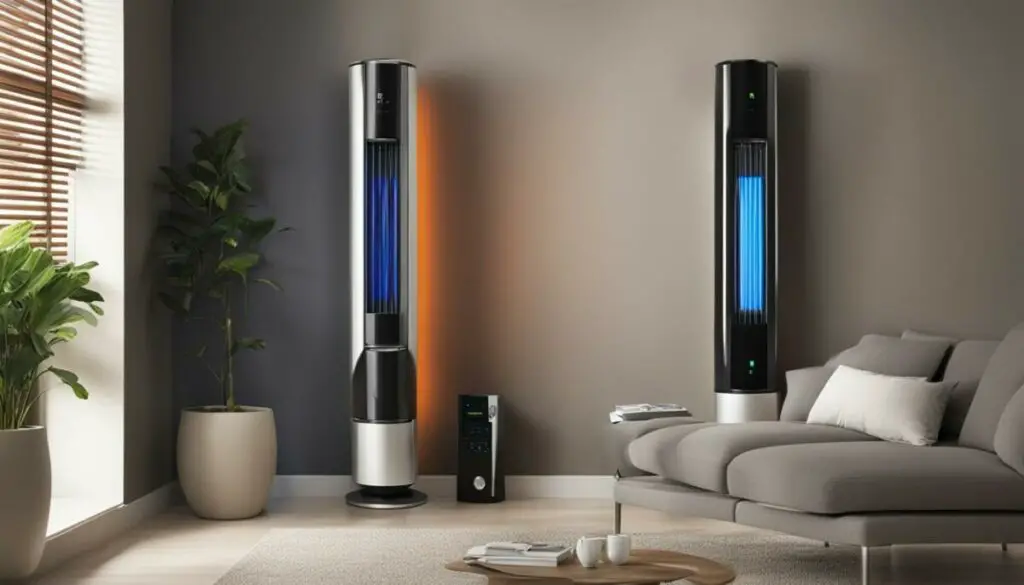
When it comes to choosing a heater, energy efficiency and cost-effectiveness are crucial factors to consider. In this section, we’ll compare the pros and cons of infrared and convection heaters in terms of energy consumption and overall cost.
Energy-efficient Infrared Heaters
One of the main advantages of infrared heaters is their energy efficiency. These heaters rely on electromagnetic radiation to directly warm up objects, so they don’t waste energy heating up the air in the room. As a result, infrared heaters can be up to 50% more energy-efficient than convection heaters. They also heat up quickly and can maintain a consistent temperature, which means you don’t have to run them for long periods to feel the warmth.
However, it’s important to note that the energy efficiency of infrared heaters can be influenced by several factors, such as the size of the room, the type of objects in it, and the insulation of the space. Infrared heaters work best in smaller rooms or spaces with low ceilings and can struggle to warm up larger areas.
Cost-effective Convection Heaters
Convection heaters work by heating up the air in the room and circulating it to provide warmth. These heaters are generally cheaper to buy than infrared heaters and can be a cost-effective option for larger rooms or spaces. They also tend to work well in rooms with high ceilings or spaces that are poorly insulated.
However, convection heaters can be less energy-efficient than infrared heaters, as they waste energy heating up the air in the room. This means you may have to run them for longer periods to maintain a consistent temperature, which can increase your energy bills.
Pros and Cons of Infrared and Convection Heaters
To summarize, here are the key pros and cons of infrared and convection heaters in terms of energy efficiency and cost-effectiveness:
| Heater Type | Pros | Cons |
|---|---|---|
| Infrared Heaters | Energy-efficient; direct heat; heats up quickly; maintains consistent temperature | May struggle to warm up larger areas; can be influenced by room size and insulation |
| Convection Heaters | Cheaper to buy; suitable for larger rooms; works well in poorly insulated spaces | Less energy-efficient; heats up the air in the room; may need to be run for longer periods |
Ultimately, the choice between infrared and convection heaters depends on your specific heating needs and preferences. Consider factors such as room size, insulation, energy efficiency, and cost-effectiveness to make an informed decision.
Heat Distribution and Heating Capacity

When comparing infrared and convection heaters, it’s important to consider how they perform in terms of heat distribution and heating capacity. Infrared heaters emit heat through radiation, which means that their heating capacity is often limited to the immediate area in front of the unit. This makes them ideal for smaller rooms or for providing spot heating in larger rooms.
Convection heaters, on the other hand, rely on heating the air and circulating it throughout the room. This results in more even heat distribution and higher heating capacity, making them a better choice for larger rooms or for heating an entire living space.
Comparing Heat Distribution
To better understand the differences in heat distribution between infrared and convection heaters, let’s take a look at the following table:
| Heater Type | Heat Distribution |
|---|---|
| Infrared | Heat is emitted through radiation and heating capacity is limited to the immediate area in front of the unit. |
| Convection | Heat is circulated throughout the room, resulting in more even heat distribution and higher heating capacity. |
As you can see, while infrared heaters may be better for spot heating, convection heaters are the better option for heating larger areas.
Comparing Heating Capacity
To further understand the differences in heating capacity, let’s take a look at the following table:
| Room Size | Infrared Heater | Convection Heater |
|---|---|---|
| Small Room (100 sq. ft.) | Can easily heat the entire room. | May be too powerful for the room. |
| Medium Room (250 sq. ft.) | Can effectively heat the immediate area in front of the unit. | Suitable for heating the entire room. |
| Large Room (500 sq. ft.) | May struggle to effectively heat the entire room. | Ideal for heating larger areas and distributing heat evenly throughout the room. |
As shown in the table, convection heaters are better suited for larger rooms and have a higher heating capacity overall. However, infrared heaters can be a good option for smaller rooms or for providing spot heating in larger rooms.
Factors to Consider in Choosing Your Heater
Choosing between an infrared and convection heater requires careful consideration of several factors. Here are some key points to keep in mind:
Heating Needs
The type of heater you choose will largely depend on your heating needs. If you need heat in a large, open space, a convection heater may be a better option as it can heat the air and circulate it throughout the room. However, if you need to heat a smaller, enclosed area, an infrared heater may be more efficient as it can directly warm objects and people in the room.
Energy Efficiency and Cost-effectiveness
Both infrared and convection heaters can be energy-efficient and cost-effective, depending on the model you choose. In general, infrared heaters are considered more energy-efficient as they can heat a space faster and require less electricity to operate. However, convection heaters can be cost-effective in the long run as they can maintain a consistent temperature in a larger space, reducing the need for constant heating cycles.
Safety Features
Safety should always be a top priority when choosing a heater. Infrared heaters are generally considered safer as they do not get as hot as convection heaters, reducing the risk of burns or fires. However, both types of heaters should have safety features such as automatic shut-off switches and overheat protection to ensure safe operation.
Personal Preferences
Personal preferences can also play a role in choosing between infrared and convection heaters. If you prefer a heater that is quiet and unobtrusive, an infrared heater may be a better option as it operates silently and does not produce any drafts. However, if you prefer a heater that can provide comfortable warmth throughout a large space, a convection heater may be more suitable.
Pros and Cons Summary
| Pros of Infrared Heaters | Cons of Infrared Heaters |
|---|---|
| Energy-efficient | May not provide consistent heating in larger areas |
| Quiet operation | May not be suitable for large open spaces |
| Directly warms objects and people | Can be more expensive upfront |
| Pros of Convection Heaters | Cons of Convection Heaters |
|---|---|
| Can heat larger areas more consistently | May produce drafts and noise |
| Cost-effective in the long run | May take longer to heat a space |
| Can be used in various settings | Can be bulky and not aesthetically pleasing |
Ultimately, the choice between infrared and convection heaters depends on your individual needs and preferences. Consider the above factors carefully before making a decision.
Conclusion
After exploring the differences between infrared and convection heaters, it ultimately comes down to personal preference and specific heating needs.
Infrared heaters are great for direct heating of objects, providing quick warmth and are frequently the best option for small rooms. Additionally, they can be more efficient compared to convection heaters, which is great for electricity bills and the environment.
On the other hand, convection heaters are exceptional for whole-room heating, and their extensive heat distribution system can encompass more significant spaces compared to infrared heaters. Additionally, some models come with advanced features such as safety mechanisms and air filters.
Considering all of the factors, we cannot declare one of them as the absolute winner. It all depends on the personal preference and the specific needs of the consumer. We recommend assessing your heating needs and the room size when making this decision.
In conclusion, both infrared and convection heaters can provide efficient and affordable heating solutions. Therefore, it is imperative to assess the pros and cons of each and then decided which one is better suited to your needs. We hope this article has helped you make an informed decision.
FAQ
Which is better, an infrared or convection heater?
The choice between an infrared and convection heater depends on your heating needs and preferences. Infrared heaters provide direct heat to objects and people, making them ideal for targeted heating in smaller spaces. Convection heaters, on the other hand, heat the air and circulate it, providing more consistent warmth throughout larger rooms. Consider factors such as energy efficiency, cost-effectiveness, and heating capacity when making your decision.
What are the benefits of infrared heaters?
Infrared heaters offer several advantages. They provide instant heat, warming up objects and people directly without needing to heat the surrounding air. This makes them energy efficient and cost-effective. Infrared heat is also gentle and comfortable, similar to the warmth of the sun. Additionally, infrared heaters do not reduce humidity or oxygen levels in the room.
What are the benefits of convection heaters?
Convection heaters have their own set of benefits. They distribute heat evenly throughout a room, making them suitable for larger spaces. Convection heaters also tend to have a lower upfront cost compared to infrared heaters. They are versatile and can be used with various heating sources, including gas, electricity, or oil. Additionally, convection heaters do not emit any harmful gases or radiation.
How does an infrared heater work?
Infrared heaters work by emitting infrared radiation, which directly heats objects and people in its path. Unlike convection heaters, they do not rely on warming the air to provide warmth. Infrared heaters use heating elements such as quartz or ceramic that produce infrared waves, which are absorbed by objects and converted into heat.
How does a convection heater work?
Convection heaters operate by heating the air and circulating it within a room. These heaters typically have an enclosed heating element that heats the air, which then rises and creates a cycle of warm air rising and cool air sinking. This process results in even heat distribution throughout the room.
Are infrared heaters more energy efficient?
Infrared heaters are generally considered to be more energy efficient than convection heaters. Since they directly heat objects and people, they waste less energy on heating the surrounding air. However, the energy efficiency of a heater also depends on other factors such as insulation and the size of the room being heated.
Are convection heaters more cost-effective?
Convection heaters often have a lower upfront cost compared to infrared heaters. However, their cost-effectiveness also depends on factors such as the energy source used and the heating needs of the space being warmed. Additionally, the maintenance and repair costs of a heater should also be considered when assessing its overall cost-effectiveness.
Which type of heater is better for large rooms?
Convection heaters are generally better suited for large rooms because they provide more even heat distribution. The circulating air helps to keep the entire space warm, ensuring that no areas are left cold. Infrared heaters, although effective for targeted heating, may struggle to provide consistent warmth throughout a larger area.
What factors should I consider when choosing between an infrared and convection heater?
When selecting a heater, consider factors such as the size of the space you need to heat, your heating needs, the energy efficiency of the heater, the heating capacity, and any safety features that are important to you. It’s also a good idea to read reviews and compare different models to find the one that best suits your requirements.

